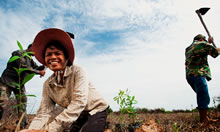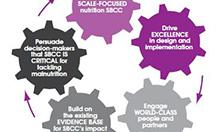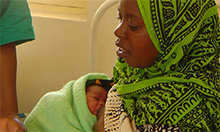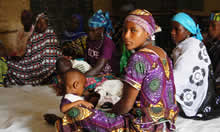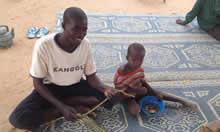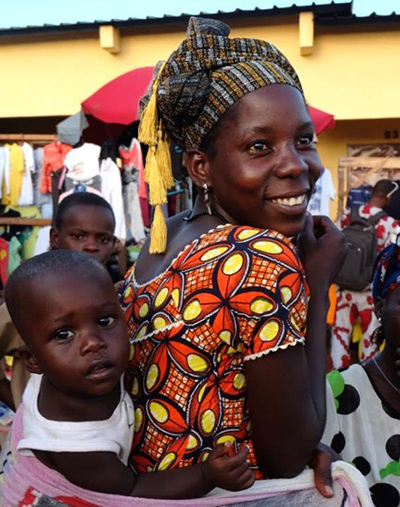
The roots of poor nutrition lie in human behavior. Improvements in nutrition are not possible without broad, widespread changes in the everyday behaviors of people and organizations around the world. In its Technical Guidance Brief for Effective At-Scale Nutrition Social and Behavior Change Communication, USAID acknowledges that “virtually all the immediate and underlying causes of malnutrition are behavioral—influenced by the behaviors of individuals and their household members. Nutrition is also influenced, however, by the behaviors of many other actors. These range from health care providers and school teachers to farmers and other agricultural agents, from religious and community leaders to private sector companies and policymakers, who collectively directly or indirectly influence care and feeding practices, household food security, the household environment, and health care services” (USAID 2017).
Evidence shows that that people can change their behaviors to improve nutrition outcomes, especially when the environment in which they live and work supports those changes. SPRING takes a behavior-centered approach to all of our work to reduce stunting and anemia, meaning that from the beginning of any intervention, we have clear behavior change goals in mind. This brief presents some of our key learning about social and behavior change (SBC) for nutrition between 2012 and 2017. We hope the information presented here will help the nutrition community to keep moving forward, catalyzing change at scale by empowering key populations and creating enabling policy, market, and social environments.
For a basic introduction to social and behavior change communication (SBCC) for nutrition, which is also informed by SPRING’s SBC learning, see the Multi-Sectoral Nutrition Strategy 2014–2025 Technical Guidance Brief: Effective At-Scale Nutrition Social and Behavior Change Communication, USAID, 2017 here.
Social and behavior change (SBC) is an approach to programming that applies insight about why people behave the way they do, and how behaviors change within wider social and economic systems, to affect positive outcomes for and by specific groups of people (SPRING 2017). Nutrition SBC aims for social and individual behavior changes that improve nutrition outcomes for priority groups.
Nutrition social and behavior change communication (SBCC) is a set of interventions that combines elements of interpersonal communication, social change and community mobilization activities, mass media, and advocacy to support individuals, families, communities, institutions, and countries to adopt and maintain high-impact nutrition-related practices. Effective nutrition SBCC seeks to increase the factors that encourage these behaviors while reducing the barriers to change (USAID 2017).
As with many rapidly developing fields, language related to SBC programming changes so fast that it can be hard to find terms that are clear to all readers. When SPRING began in 2012, the phrase “social and behavior change communication” was used widely by USAID and implementing partners to indicate a whole range of interventions that facilitate behavior change within a broad array of development programs. Emphasis, however, was largely placed on communication approaches and the development of communication tools and platforms. Over the life of SPRING, we shifted to a more comprehensive behavior-centered perspective. Our shift reflects the general behavior change field’s simultaneous recognition of SBCC as a sub-component of SBC. Today, more people use the term “social and behavior change,” with the understanding that communication remains an important—but not the only—element of programming approaches.
Nutrition SBC Compared to SBC for Other Fields
Taking a behavior-centered approach to nutrition means that throughout the design, implementation, and monitoring of a nutrition intervention, all stakeholders have clear behavior change goals in mind. Evidence shows that people can change their behaviors to improve nutrition outcomes, especially when the environment in which they live and work supports those changes. Two comprehensive summaries of evidence are:
- “Population-Level Behavior Change to Enhance Child Survival and Development in Low- and Middle-Income Countries: A Review of the Evidence.” Special Issue. Journal of Health Communication 19(1).
- Evidence of Effective Approaches to Social and Behavior Change Communication for Preventing and Reducing Stunting and Anemia: Findings from a Systematic Literature Review. Arlington, VA: SPRING. Available here.
The “social” in SBC is especially important for nutrition SBC. Catalyzing sustainable behavior change at scale requires empowering key populations and creating enabling policy, market, and social environments. Individual- and family-level behavior change can be particularly challenging when it comes to nutrition because:
- Nutrition decisions and behaviors happen multiple times per day, and are often unconscious/by habit.
- Most desired nutrition outcomes require people to try new behaviors and sustain them over time.
- Dietary choices and other eating-related behaviors are often strongly tied to cultural and social norms. People around us (family, friends, and wider social circles) have a strong influence on what we eat.
- Nutrition-related resources vary widely by geographic area and time of the year, and are shaped by local agricultural and market systems.
Developing an Evidence-Based Conceptual Framework
SPRING’s work across multiple contexts and types of partners (local nongovernmental organizations, academic institutions, Ministries of Health, Gender, Labor, and/or Agriculture, and multi-lateral agencies) is guided by a common understanding of the science of SBC and a commitment to incorporating new insights and approaches while getting the basics right for effective SBC design and implementation. Our work culture allowed us to expand and scale our programming while maintaining consistency and quality. Over the course of the project, our understanding of the evidence for nutrition SBC and our experience applying that evidence to effective at-scale programming became our conceptual framework, outlined below. This framework has helped us explain our SBC thinking to new colleagues and partners, and has guided design, implementation, monitoring, and strategy adjustments.
SPRING’s SBC Framework incorporates elements of the UNICEF Conceptual Framework on Nutrition (UNICEF 1990) and was guided by a systematic review of the evidence for nutrition SBC (SPRING 2014) and an expert working group (SPRING 2015). The framework uses simple terms to describe how SPRING and partners can improve dietary intake and the health and nutritional status of populations through interventions including but not limited to communicating through multiple channels, audiences, and strategies. As stated in the framework, by using proven delivery strategies to engage populations, programs can strengthen enablers and reduce barriers to behavior to increase the uptake of nutrition-specific and nutrition-sensitive practices to improve nutritional status.
The boxes along each row delineate key programming elements (delivery strategies, populations, determinants of behavior, priority practices/behaviors, and impacts) into sub-categories drawn from evidence-based behavior change models and nutrition conceptual frameworks. These boxes help programmers make decisions to increase the likelihood that the interventions they are designing result in behavior change and improved outcomes.
The phrase along the right of the framework reminds programmers of the importance of high-quality design, monitoring, and implementation. SPRING considers high-quality SBC as—
- aiming for equity, system strengthening, scalability, and sustainability from initial assessment and design through program closeout
- ensuring meaningful participation by program participants and stakeholders
- fostering clear expectations, accountability, and transparency for ourselves and all partners.
Nutrition Social and Behavior Change Framework
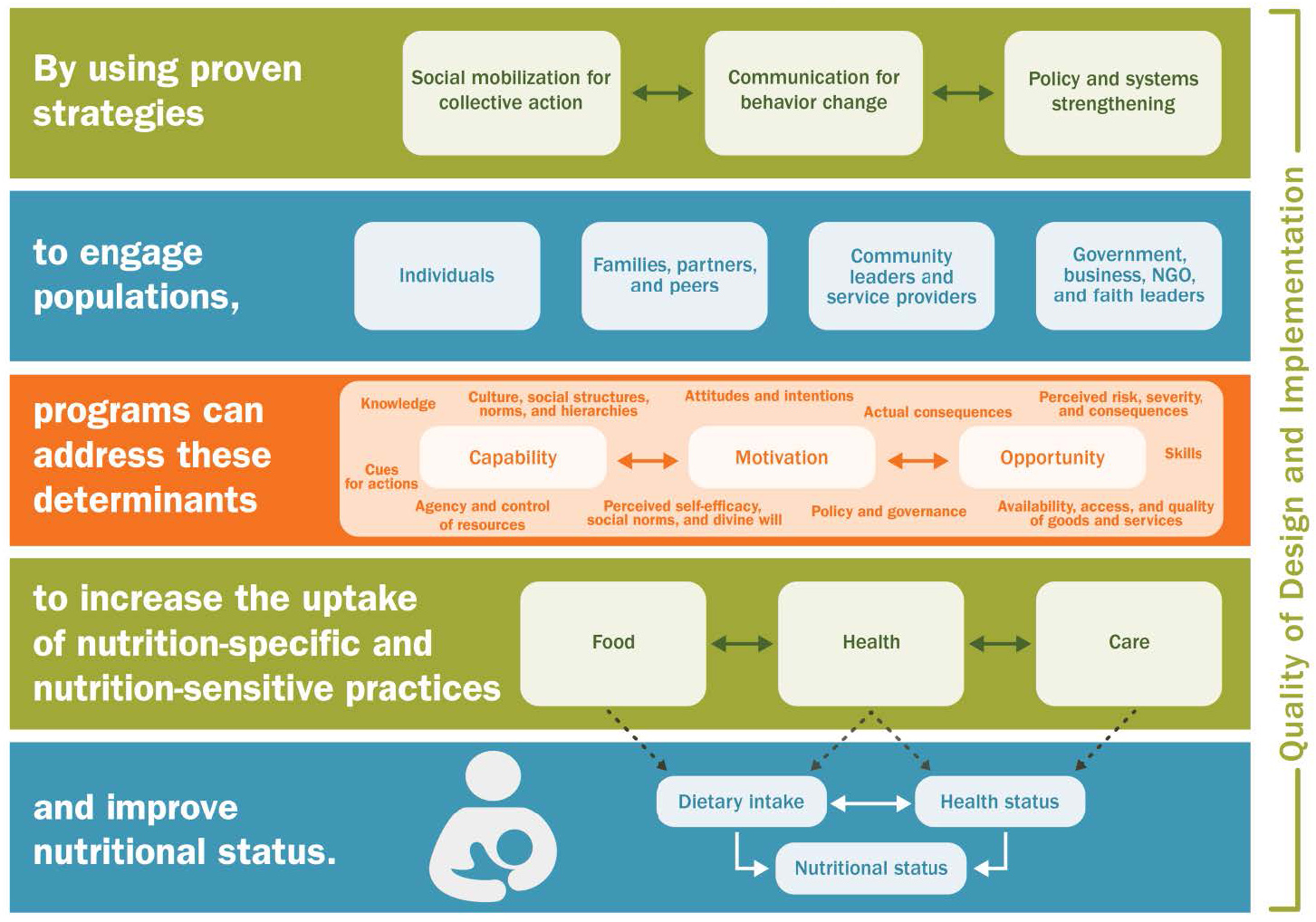
The Framework in Action
A focus on behavior underpins all the work that SPRING has done across our global portfolio, from helping government ministries monitor nutrition spending and building health worker capacity for nutrition counseling and support to working with farmers to improve production yields and manage budgets to enhance household consumption of nutritious foods. The following examples of SPRING's multi-sectoral nutrition programming provide a snapshot of what each row of our framework looks like in action and how it contributes to improved nutrition outcomes. For a broader overview of SPRING’s global- and country-level nutrition SBC work, please visit this page.
Adapting and Scaling Proven Strategies
From India to the Sahel: Adapting a Community Video Approach across Platforms
To improve population-level nutrition outcomes, we must reach enough people with evidence-based SBC interventions and strengthen policies, markets, and physical and social environments to influence behaviors. SPRING has developed, adapted, and scaled proven strategies to new contexts and sectors to contribute to population-level change.
In 2014, SPRING began working with vulnerable populations in Niger and Burkina Faso to implement a peer-based community-led video approach to improve nutrition and hygiene. The community video model was first developed and tested for nutrition by SPRING and Digital Green in India, then adapted and rolled out in the Sahel, Guinea, and Senegal. In each context, the specific content of the videos as well as the groups that produced and disseminated them varied according to needs and available resources. However, the core idea of the approach remains the same: when people see their peers engaged in particular behaviors, they are more likely to practice them.
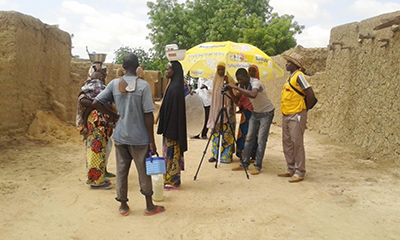
A key to successful adaptation and scaling of the community video approach in the Sahel was leveraging partnerships with established projects to engage key populations. SPRING worked with organizations that had been in the Sahel for years, which accelerated introduction and scale up of the approach to communities and expanded reach. We worked with communities and partner staff to develop locally appropriate media content, build community capacity in nutrition and media expertise, and ultimately transfer ownership of the media processes and the equipment to local partners. Community video was especially appealing for partners because videos could be developed rapidly and allowed great flexibility in the types of information and topics conveyed. Community video is a communication platform that allows programs to respond rapidly to shocks (including conflict, drought, and food shortages) with precise information. As seen in the framework, SPRING began by leveraging a proven SBC approach and adapting it to fit the context through formative research. Our research identified specific populations and determinants of behavior change, which informed program design and led to positive behavior change.
Engaging Populations
Social connections and a sense of belonging are vital to human well-being. Decades of evidence on social change and behavior change indicate that our actions are not determined in isolation; other people shape our beliefs, attitudes, intentions, and actual behaviors. To create enabling physical, social, market, and policy environments for people to practice improved behaviors, SBC interventions must reach the prospective “doers” of a promoted practice as well as the groups of people who are most likely to influence those “doers”. Using a mix of appropriate methods to reach “doers” and influencing groups is fundamental to effective SBC interventions but can be challenging because appropriate program-delivery platforms and approaches may vary by target audience. Influencing groups may vary by behavior or group of “doers,” so it is important to focus on the correct influencers and to verify our assumptions about influencers and “doers” periodically through program observation and monitoring.
Tailoring Communication Interventions to Urban Populations in Kyrgyzstan
In the Kyrgyz Republic, SPRING conducted formative research to learn about the factors that affect family food consumption, diet, water, sanitation, and hygiene (WASH), and care practices. Our findings helped us select 11 household pro-nutrition practices and design SBC interventions to support the uptake of those practices. SPRING and our partners prioritized these practices because they were effective and feasible as measured against caregivers’ financial resources, time, and attention. Our interventions used community volunteers to visit all households with pregnant women or young children in their coverage area to promote improved household practices and generate demand for health services among mothers, fathers, and grandmothers. Community and mass media activities complemented these interventions by promoting greater involvement of fathers and grandmothers in child care, and reminding families about priority practices like ensuring that mothers and young children (6–23 months of age) consume micronutrient-rich foods like green and orange vegetables, pulses, meat, milk, and eggs every day.
Kyrgyzstan has a family-centered culture that prioritizes healthy, smart children. Fathers expect to be involved and enjoy spending time with children. On the other hand, newly married women may have low status in the household, especially related to their mothers-in-law. One of the barriers to increasing the number of women and children eating sufficient and diverse diets is that women and children often eat last. Another is that mothers’ time for childcare may be limited by working in or outside the home. Community meetings focused on the role of fathers and grandmothers in nutrition during the 1,000 days and concluded by asking participants to commit to trying one or more of the supportive behaviors being promoted. Finally, television spots featured role-model fathers, grandmothers, and grandfathers supporting improved diet, caring, WASH, and health-care seeking practices at home.
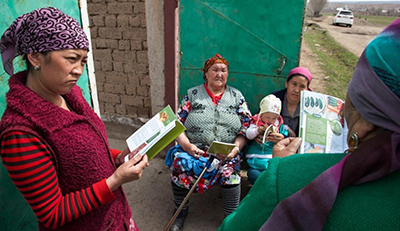
After a few months, supervision and monitoring data showed that retaining volunteers in urban areas was considerably more difficult than in rural areas. In addition, urban families were not as accepting of volunteers as sources of health and nutrition information. SPRING adjusted its approach for urban audiences by focusing on fewer key practices and adapting activities to urban audiences. For example, we adapted to reach newly married couples by inviting new or expectant fathers to existing facility-based courses for pregnant women and helping facility staff integrate nutrition education into these “mothers and fathers” sessions. SPRING also reached out to different implementing partners in urban areas, engaging local facility-based health promotion workers to hold nutrition-focused community events, and orienting regional television, radio, and newspaper media staff to key maternal and child nutrition issues in Kyrgyzstan.
The mix of communication activities in urban areas included professionally produced celebrity concerts that were attended by 9,000 people over two weeks. These shows raised the profile of nutrition issues, and were a fun and memorable way to deliver pro-nutrition messages to audiences, which included many young families. Live action and animated videos shared through SPRING’s popular Facebook page and broadcast on television complemented urban community events by reinforcing norms on family support for mothers’ and children’s nutrition, and reminding audiences of key diet, handwashing, and care practices. As of December 2017, over 183,000 individual Facebook users had seen SPRING videos.
The mix of communication activities in urban areas included professionally produced celebrity concerts that were attended by 9,000 people over two weeks. These shows raised the profile of nutrition issues, and were a fun and memorable way to deliver pro-nutrition messages to audiences, which included many young families. Live action and animated videos shared through SPRING’s popular Facebook page and broadcast on television complemented urban community events by reinforcing norms on family support for mothers’ and children’s nutrition, and reminding audiences of key diet, handwashing, and care practices. As of December 2017, over 183,000 individual Facebook users had seen SPRING videos.
Addressing Determinants of Behavior to Increase Uptake of Improved Practices
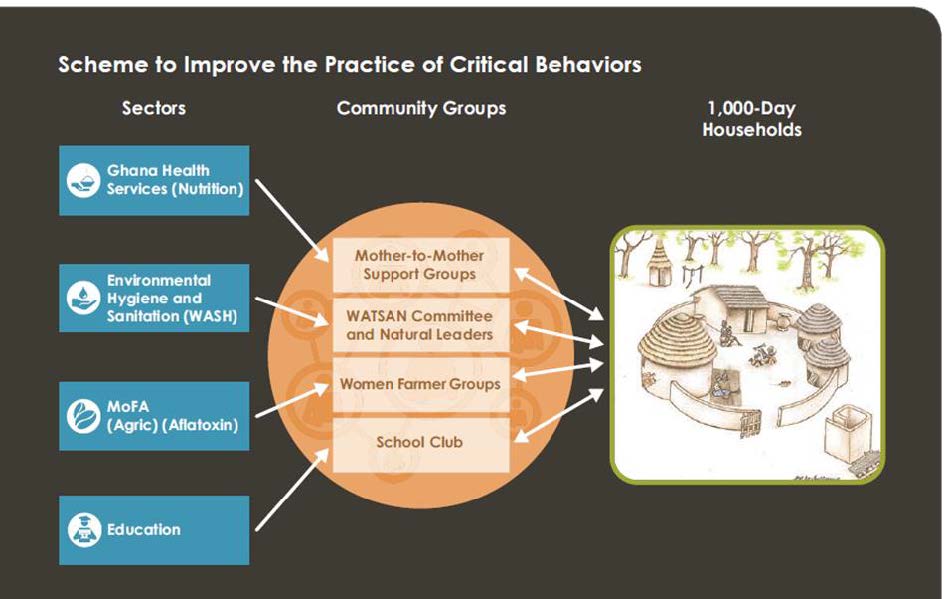
In many of the places where SPRING works, multiple barriers make it difficult or risky for people to practice the nutrition behaviors we promote. There may also be enablers that facilitate adoption of these behaviors. Just as it is important to identify the right audiences and populations, we must also uncover the relevant determinants of behavior to catalyze change. Once we identify barriers and enablers to key practices, we must prioritize what we can influence within project resources and context.
The Integrated 1,000-day Household Approach in Ghana
In Ghana, SPRING set out to improve household, community, and facility-level nutrition practices through three primary delivery strategies: community and social mobilization; behavior change communication; and systems strengthening. SPRING developed the Integrated 1,000 Day Household Approach, which focused on households with pregnant and lactating women and children under the age of two. Based on initial research examining the local causes of stunting, SPRING designed a multi-sectoral response that addressed issues related to infant and young child feeding, WASH, and agriculture to contribute to improved nutrition outcomes. As the figure below shows, sector partners implemented SBC activities through existing community groups that engaged various members of 1,000-day households.
The team defined and prioritized key behaviors to mitigate major causes of stunting. Partners decided to promote increased consumption of animal-source foods by young children; consistent consumption of three meals each day; clean play spaces for young children; improved handwashing and latrine use; and better agricultural, food storage, and preparation practices to reduce aflatoxins. SPRING used in-depth analysis to uncover determinants to motivate behavior change. Many families were hindered by severe economic situations and social barriers and enablers tied to a male-dominated society.
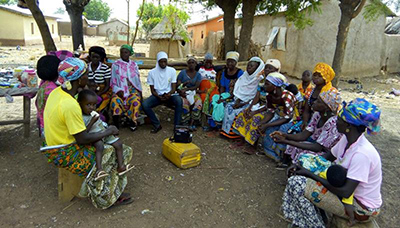
The resulting SBC strategy focused on the following key behavioral factors:
Motivation: Men desired opportunities for leadership and took pride in doing something for their community and children’s futures. SBC activities fostered a commitment to working as a family or community to achieve a set goal.
Capability: Another focus was strengthening skills for service provision and caring practices in nutrition, WASH, and nutrition-sensitive agriculture. SPRING supported health facility personnel, environmental health officers, agriculture extension workers, and caregivers. We engaged mother support groups and village elders with radio programs and videos of feeding practices, and taught female farmers about reducing aflatoxins.
Opportunity: The lack of money and resources to conduct specific behaviors, such as using a latrine, was a barrier to adopting these practices. SPRING responded to such structural barriers, as we were able, by constructing tippy taps and latrines, establishing and supporting village savings and loan associations and providing access to certain agricultural tools and activities.
These multi-faceted efforts resulted in substantial changes in behavior and health outcomes in project areas. The prevalence of children 6–23 months receiving a minimum acceptable diet was 9.5 percent at baseline and 29.5 percent at endline. The percentage of households with improved groundnut storage systems to reduce aflatoxin levels increased by 15 percentage points, and those with functional tippy taps in recommended locations went from just 1.4 percent to 16.6 percent. Most notably, the prevalence of stunting in children under five decreased from 29.5 percent to 23 percent. These powerful results show what can be achieved in a relatively short amount of time by designing and implementing SBC programs, using a strategic framework like the one presented here to ensure that programming is behavior-centered.
Uncovering Enablers as Well as Barriers: Ideal Family Relationships and Joint Decision-Making across Contexts
Knowing that high demands on women’s time and labor affect nutrition outcomes, SPRING looked at how families can provide better support for women. We found that family harmony, including respectful communication, mutual decision-making, and sharing of everyday tasks, is a common aspiration for mothers, fathers, and grandmothers alike. This has held true across contexts from South and Central Asia to East and West Africa. We incorporated this ideal to enable improved family support related to a wide range of agriculture, health, hygiene, and care practices. As with any practice, people need skills, self-efficacy, and support to communicate openly and to follow through on decisions made together. Improving family communications and men’s engagement became a deliberate aspect of SPRING’s SBC work across country teams.
SPRING focused on adapting resources for healthy communication and mutual decision-making to each context and family member role. We incorporated these resources into capacity strengthening for health staff, agriculture extension workers, community leaders, and volunteers. Our results from this focus on skills and confidence for communication and mutual decision-making were encouraging. For example, in the Sahel, community videos encouraged conversations between mothers and fathers about child nutrition—conversations that had not occurred prior to the intervention. Fathers also started providing a higher level of childcare support (SPRING 2016a).
Conclusion
A critical lesson from our SBC programming is the importance of catalyzing change using available resources. This means tailoring design, implementation, and monitoring to partner and local priorities and competencies. We have also learned that nutrition SBC is most effective when partners work toward longer-term social, physical, and market environment changes, while also facilitating faster change in a limited number of specific, feasible, and high-impact practices.
Adapting existing design methods and implementation approaches for use across sectors, rather than re-creating them, helped us achieve our goals relatively quickly. Using SPRING’s Nutrition SBC Framework to reinforce with all stakeholders why and how behavior-centered programming works has also been key to achieving results. We have learned that amplifying our own and others’ successes, challenges, and learning, and establishing connections to nutrition SBC stakeholders across countries and sectors are key to moving the field of social and behavior change forward. This learning brief is shared in that spirit.
References
SPRING. 2014. Evidence of Effective Approaches to Social and Behavior Change Communication for Preventing and Reducing Stunting and Anemia: Findings from a Systematic Literature Review. Arlington, VA: Strengthening Partnerships, Results, and Innovations in Nutrition Globally (SPRING) project. Available at https://www.spring-nutrition.org/publications/series/evidence-effective-....
SPRING. 2015. Designing the Future of Nutrition SBCC: How to Achieve Impact at Scale. Conference Report and Strategic Agenda. Arlington, VA: Strengthening Partnerships, Results, and Innovations in Nutrition Globally (SPRING) project. Available at https://www.spring-nutrition.org/publications/reports/conference-report-....
SPRING. 2016a. The Father Factor: How Community Video Encourages Male Involvement for Better Nutrition and Hygiene Behaviors in Niger. Evidence from the SPRING Community Video Experience. Arlington, VA: Strengthening Partnerships, Results, and Innovations in Nutrition Globally (SPRING) project. Available at https://www.spring-nutrition.org/publications/reports/father-factor.
SPRING. 2017. Accelerating Behavior Change in Nutrition-Sensitive Agriculture Online Training Course. Arlington, VA: Strengthening Partnerships, Results, and Innovations in Nutrition Globally (SPRING) project. Available at https://www.spring-nutrition.org/publications/training-materials/acceler....
SPRING. n.d. Endline Nutrition Survey in the Kyrgyz Republic, Analytical Report. Arlington, VA: Strengthening Partnerships, Results, and Innovations in Nutrition Globally (SPRING) project. Forthcoming.
United Nations Children’s Fund (UNICEF). 1990. Strategies of Improving Nutrition of Children and Women in Developing Countries. New York: UNICEF.
USAID. 2017. Multi-Sectoral Nutrition Strategy 2014–2025 Technical Guidance Brief: Effective At-Scale Nutrition Social and Behavior Change Communication. Washington, DC: U.S. Agency for International Development.
